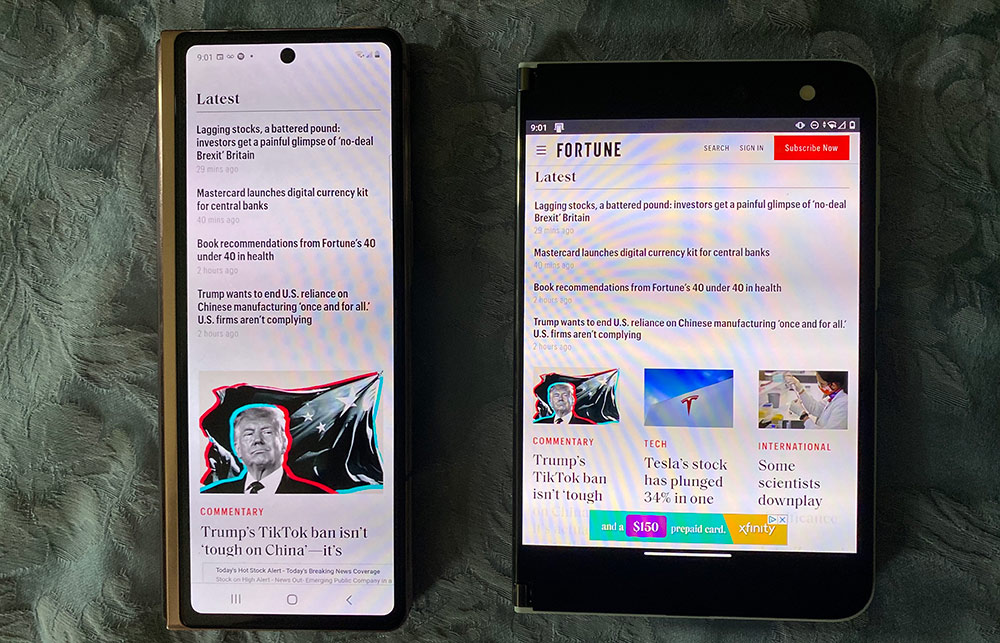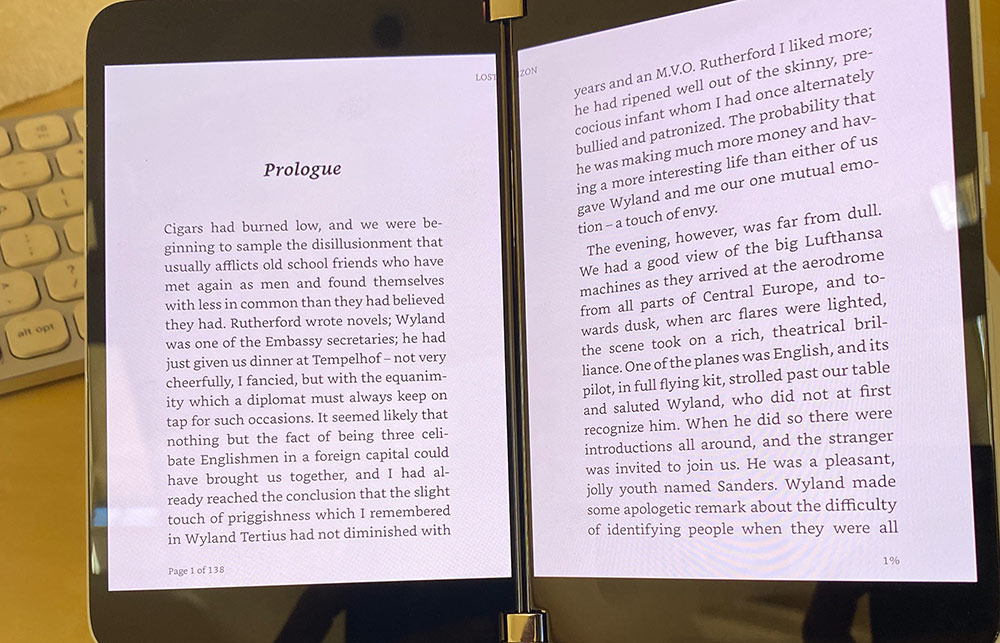四年前,由于消费者不爱用微软(Microsoft)的手机平台,更喜欢苹果( Apple)和谷歌(Google)的平台,微软叫停了自己的手机生产。但俗话说,如果你不能打败他们,就加入他们。
9月10日,微软又推出了新的Surface Duo手机,一款能够反映手机流行趋势的独特折叠手机,搭载谷歌的安卓操作系统,运行的大多是微软自己的应用程序。这款设备外形非常好看,售价1400美元,我已经用了好几个星期,感觉微软重返移动手机市场,还是有很多值得喜欢的地方。但是,手机也缺少了一些元素,而这些元素不仅是市面上大多数竞品手机的必备(无论是折叠还是传统手机),也是生活中必不可少的功能。
Surface Duo的性能
微软一直都是软件巨头,而其硬件业务也在首席产品官帕诺斯•帕纳伊的领导下得到了提升。Surface Duo是帕纳伊目前最自豪的成绩之一。
从明亮的白色玻璃外壳到清晰的5.6英寸双内屏,这款手机的硬件绝对令人惊叹。由于有两个设计巧妙的铰链,两块屏幕开合时安静平滑,可以展开到360度。这款手机没有选择很多折叠手机都会用的可弯曲屏幕,而是用了两块不同的屏幕,中间折叠处有一个清晰可见的空隙。

Surface Duo在打开状态下,是我见过最薄的移动设备,只有4.8毫米,勉强能够装下USB-C接口。即使是对折,也不比iPhone 11 Pro Max或三星Galaxy S20 Ultra厚多少。而且没有难看的摄像头凸起(这点有好也有不好——下面会细说)。
硬件上另一个亮点是3比2的屏幕比例,和微软的Surface笔记本电脑一样。现在大多数智能手机的屏幕越来越高、越来越窄,比例达到了16比9,甚至21比9,Surface Duo却反其道而行。屏幕变宽可以提高生产力,因为这样手机上的应用程序就有更多的展示空间,能够显示更多信息。网站可以利用宽出来的部分显示更多的故事。

Surface Duo与微软的Surface触控笔兼容,能够用来写笔记、做标注、编辑文本,也可以用来代替手指滑动屏幕。与更窄更长的手机相比,它的宽显示屏也让书写更舒服。
不过,Surface Duo的研发启动于很早之前,从手机一些不那么先进的性能就能够看出这一点。
处理器是高通骁龙855,常见于2019年发布的旗舰手机。也没有5G,运营商正慢慢在全国推广这种超高速的新无线技术,今年大多数新手机都加入了5G。与采用几乎全玻璃面板的竞争对手相比,Surface Duo两块屏幕顶部和底部的边框都很大。
有些人觉得把这款宽屏手机对折贴在耳朵上打电话很尴尬,我却很快就习惯了。通话质量很好,用你最喜欢的无线蓝牙耳机(抱歉,没有耳机插孔)通话质量更好。
还有相机的问题。帕纳伊曾经说过,拍照不是Surface Duo的关注点,的确如此。这款手机只有一个摄像头,位于右侧内屏上方,外侧没有摄像头。这意味着没有广角镜头或长焦镜头。
这款1100万像素的相机对于自拍来说还不错,但要拍一张普通的照片,就得把手机的两个屏幕都翻折,都要正面朝外,还要确保相机可以正确指向拍摄对象。可能因为我是右撇子,而相机又在折角的右侧屏上,拍照偶尔会出现很尴尬的情况。在我找好两块屏幕的角度后,有时相机是对着我的,而不是我的拍摄对象,而手机还处于自拍模式。把手机翻过来就能够解决这个问题,因为软件会立即调整,但每次都要这样就很烦人。
和其他手机上的顶级相机相比,拍摄出来的照片看起来,缺那么一点鲜活的色彩和精致的细节。但肖像、全景和视频模式都还不错。
一款生产力机型
Surface Duo分屏设计最明显的好处是,你可以并排显示两个不同的应用程序。
你能够在一个屏幕上用Chrome浏览器读文章,在另一个屏幕上用OneNote做笔记。或者在一个屏幕上用Zoom开视频会,同时在另一个屏幕上查看幻灯片。据说,微软的首席执行官萨蒂亚•纳德拉非常喜欢在这款手机的一块屏幕上看书,在另一块屏幕上手写笔记。
微软甚至还给安卓系统增加了一项功能,允许用户预先选择应用程序进行配对,在主屏幕上点击一个图标就可以同时启动。
Surface Duo的双屏设计提供了同时使用两个应用程序的体验,而且比起在手机和平板电脑的一块屏幕上显示多个应用程序,感觉要更流畅、更少卡顿。但同时,这款手机的软件本身也有一些缺陷,不能总是快速适应方向变化或快速滑动应用程序。微软在审核期发布了一项软件更新,做出了重大改进,并表示以后还会有更多的更新。
你也可以把同一个应用程序铺开在两块屏幕上,但其实不太好看,很怪异,因为你要看的内容被一大块空白条从中间切开了。尽管Surface Duo的尺寸很大,但它不能像其他折叠手机那样,让你在更大的屏幕上看视频。

另一方面,微软和谷歌合作为安卓的应用程序增加了一种新的分屏模式,很多微软的应用程序都能够使用这种新模式。
使用Outlook的分屏模式,你可以在一块屏幕上看到电子邮件列表,在另一块上阅读选定电子邮件的正文内容。微软的新闻应用程序有一个“图书模式”,能够在两个屏幕上像一本书的两页一样打开。不过,我没有找到有哪个谷歌应用程序可以使用这种新模式,第三方应用程序也没有几个针对双屏设计做了更新。亚马逊的Kindle电子阅读器已经更新了,这种两页式“阅读模式”看起来可太棒了。

还不够好
Surface Duo有很多值得追捧的地方,无论是“来自未来”的外观、平滑的使用感,还是聪明的铰链设计和新的分屏应用模式。但也有一些重大失误,可能任何一个第一代创新产品都会出现这种失误。目前,很少有人(如果有的话)需要在手机中安装5G功能,但对于那些主要依靠移动设备拍照的人来说,这款手机拍照功能的不足可能会令人失望。
这让我很痛苦。当我想看电子书,想一边刷推特一边浏览网站,想在四处奔波中(目前这种情形十分有限)做点事时,我的第一选择时Surface Duo。但当我想给狗狗拍张萌照,想放松一下看看YouTube视频时,其他设备就会浮现在我的脑海里。
黑莓刚面世的时候,很多人都会随身携带两部手机,一部用于工作,一部用于生活。我不想再回到那时候了。但是我还没有准备好把Surface Duo作为唯一的依靠。让我们期待一个伟大的2.0版本吧。(财富中文网)
译者:Agatha
四年前,由于消费者不爱用微软(Microsoft)的手机平台,更喜欢苹果( Apple)和谷歌(Google)的平台,微软叫停了自己的手机生产。但俗话说,如果你不能打败他们,就加入他们。
9月10日,微软又推出了新的Surface Duo手机,一款能够反映手机流行趋势的独特折叠手机,搭载谷歌的安卓操作系统,运行的大多是微软自己的应用程序。这款设备外形非常好看,售价1400美元,我已经用了好几个星期,感觉微软重返移动手机市场,还是有很多值得喜欢的地方。但是,手机也缺少了一些元素,而这些元素不仅是市面上大多数竞品手机的必备(无论是折叠还是传统手机),也是生活中必不可少的功能。
Surface Duo的性能
微软一直都是软件巨头,而其硬件业务也在首席产品官帕诺斯•帕纳伊的领导下得到了提升。Surface Duo是帕纳伊目前最自豪的成绩之一。
从明亮的白色玻璃外壳到清晰的5.6英寸双内屏,这款手机的硬件绝对令人惊叹。由于有两个设计巧妙的铰链,两块屏幕开合时安静平滑,可以展开到360度。这款手机没有选择很多折叠手机都会用的可弯曲屏幕,而是用了两块不同的屏幕,中间折叠处有一个清晰可见的空隙。
Surface Duo在打开状态下,是我见过最薄的移动设备,只有4.8毫米,勉强能够装下USB-C接口。即使是对折,也不比iPhone 11 Pro Max或三星Galaxy S20 Ultra厚多少。而且没有难看的摄像头凸起(这点有好也有不好——下面会细说)。
硬件上另一个亮点是3比2的屏幕比例,和微软的Surface笔记本电脑一样。现在大多数智能手机的屏幕越来越高、越来越窄,比例达到了16比9,甚至21比9,Surface Duo却反其道而行。屏幕变宽可以提高生产力,因为这样手机上的应用程序就有更多的展示空间,能够显示更多信息。网站可以利用宽出来的部分显示更多的故事。
Surface Duo与微软的Surface触控笔兼容,能够用来写笔记、做标注、编辑文本,也可以用来代替手指滑动屏幕。与更窄更长的手机相比,它的宽显示屏也让书写更舒服。
不过,Surface Duo的研发启动于很早之前,从手机一些不那么先进的性能就能够看出这一点。
处理器是高通骁龙855,常见于2019年发布的旗舰手机。也没有5G,运营商正慢慢在全国推广这种超高速的新无线技术,今年大多数新手机都加入了5G。与采用几乎全玻璃面板的竞争对手相比,Surface Duo两块屏幕顶部和底部的边框都很大。
有些人觉得把这款宽屏手机对折贴在耳朵上打电话很尴尬,我却很快就习惯了。通话质量很好,用你最喜欢的无线蓝牙耳机(抱歉,没有耳机插孔)通话质量更好。
还有相机的问题。帕纳伊曾经说过,拍照不是Surface Duo的关注点,的确如此。这款手机只有一个摄像头,位于右侧内屏上方,外侧没有摄像头。这意味着没有广角镜头或长焦镜头。
这款1100万像素的相机对于自拍来说还不错,但要拍一张普通的照片,就得把手机的两个屏幕都翻折,都要正面朝外,还要确保相机可以正确指向拍摄对象。可能因为我是右撇子,而相机又在折角的右侧屏上,拍照偶尔会出现很尴尬的情况。在我找好两块屏幕的角度后,有时相机是对着我的,而不是我的拍摄对象,而手机还处于自拍模式。把手机翻过来就能够解决这个问题,因为软件会立即调整,但每次都要这样就很烦人。
和其他手机上的顶级相机相比,拍摄出来的照片看起来,缺那么一点鲜活的色彩和精致的细节。但肖像、全景和视频模式都还不错。
一款生产力机型
Surface Duo分屏设计最明显的好处是,你可以并排显示两个不同的应用程序。
你能够在一个屏幕上用Chrome浏览器读文章,在另一个屏幕上用OneNote做笔记。或者在一个屏幕上用Zoom开视频会,同时在另一个屏幕上查看幻灯片。据说,微软的首席执行官萨蒂亚•纳德拉非常喜欢在这款手机的一块屏幕上看书,在另一块屏幕上手写笔记。
微软甚至还给安卓系统增加了一项功能,允许用户预先选择应用程序进行配对,在主屏幕上点击一个图标就可以同时启动。
Surface Duo的双屏设计提供了同时使用两个应用程序的体验,而且比起在手机和平板电脑的一块屏幕上显示多个应用程序,感觉要更流畅、更少卡顿。但同时,这款手机的软件本身也有一些缺陷,不能总是快速适应方向变化或快速滑动应用程序。微软在审核期发布了一项软件更新,做出了重大改进,并表示以后还会有更多的更新。
你也可以把同一个应用程序铺开在两块屏幕上,但其实不太好看,很怪异,因为你要看的内容被一大块空白条从中间切开了。尽管Surface Duo的尺寸很大,但它不能像其他折叠手机那样,让你在更大的屏幕上看视频。
另一方面,微软和谷歌合作为安卓的应用程序增加了一种新的分屏模式,很多微软的应用程序都能够使用这种新模式。
使用Outlook的分屏模式,你可以在一块屏幕上看到电子邮件列表,在另一块上阅读选定电子邮件的正文内容。微软的新闻应用程序有一个“图书模式”,能够在两个屏幕上像一本书的两页一样打开。不过,我没有找到有哪个谷歌应用程序可以使用这种新模式,第三方应用程序也没有几个针对双屏设计做了更新。亚马逊的Kindle电子阅读器已经更新了,这种两页式“阅读模式”看起来可太棒了。
还不够好
Surface Duo有很多值得追捧的地方,无论是“来自未来”的外观、平滑的使用感,还是聪明的铰链设计和新的分屏应用模式。但也有一些重大失误,可能任何一个第一代创新产品都会出现这种失误。目前,很少有人(如果有的话)需要在手机中安装5G功能,但对于那些主要依靠移动设备拍照的人来说,这款手机拍照功能的不足可能会令人失望。
这让我很痛苦。当我想看电子书,想一边刷推特一边浏览网站,想在四处奔波中(目前这种情形十分有限)做点事时,我的第一选择时Surface Duo。但当我想给狗狗拍张萌照,想放松一下看看YouTube视频时,其他设备就会浮现在我的脑海里。
黑莓刚面世的时候,很多人都会随身携带两部手机,一部用于工作,一部用于生活。我不想再回到那时候了。但是我还没有准备好把Surface Duo作为唯一的依靠。让我们期待一个伟大的2.0版本吧。(财富中文网)
译者:Agatha
Microsoft stopped making its own line of phones four years ago, as consumers rejected its mobile platform in favor of those from Apple and Google. But if you can’t beat them, join them, so the saying goes.
On September 10, Microsoft puts on sale its new Surface Duo device, a unique take on the folding phone trend that runs plenty of the company’s own mobile apps on top of Google’s Android operating system. I’ve been using the slick $1,400 device for a few weeks, and there’s a lot to love in Microsoft’s return to the mobile market. But there are also a few missing elements included in most rival phones—folding and traditional—that are hard to live without.
The Surface Duo specs
Known for most of its history as a software powerhouse, Microsoft has certainly upped its hardware game under chief product officer Panos Panay. And the Surface Duo is one of Panay’s proudest accomplishments yet.
The hardware is absolutely stunning, from the bright white glass exterior to the dual 5.6-inch sharp interior displays. Thanks to two cleverly designed hinges, the Duo opens and closes silently and smoothly over a full 360 degrees. Unlike folding phones that have bending glass screens, the Duo has two distinct screens separated by a clearly visible air gap at the crease in the middle of the device.
When opened, the Surface Duo is the thinnest mobile device I have ever beheld at just 4.8 millimeters, barely enough room to fit its USB-C port. Even folded, it’s hardly thicker than an iPhone 11 Pro Max or Samsung Galaxy S20 Ultra. And there’s no ugly camera bump (a mixed blessing—more on that below).
Another hardware highlight is the screen ratio of 3 to 2, just like Microsoft’s Surface laptops. While most smartphone screens are getting taller and narrower, with screen ratios of 16 to 9 up to even 21 to 9, the Surface Duo goes the other way. The decision to go with wider, squatter screens enhances productivity, as apps have more room to spread out and show more information. Websites can take advantage of the extra width to display more stories.
The Surface Duo is compatible with Microsoft’s line of Surface styluses, useful for writing notes, highlighting and editing text, and generally using in place of your fingers to scroll around. The wider display makes it more comfortable to scrawl across the screen than on thinner, taller phones, too.
Still, the Surface Duo has been in development for a long time, and that shows up in some less than cutting-edge specs.
The processor is a Qualcomm Snapdragon 855, which generally powered flagship phones released in 2019. There’s also no 5G, the superfast new wireless technology that carriers are slowly rolling out across the country and have included in most new phones this year. And the two screens have massive top and bottom bezels compared with rivals that have moved to nearly all-glass front displays.
Some people find the act of using the Surface Duo as a phone awkward, with the wide device folded in half pressed to your ear, but I got used to it pretty quickly. Call quality is fine and even better using your favorite pair of wireless Bluetooth earbuds (sorry, no headphone jack).
There is also the matter of the camera. Panay has said that photography was not an emphasis of the Surface Duo, and it shows. There is just one camera, located above the right-hand interior screen of the device, and there are no cameras on the outside. That means no wide angle or telephoto lenses.
The 11-megapixel shooter is decent enough for selfies, but taking a regular picture requires folding the Surface Duo with both screens facing out, and correctly pointing the side with the camera at the desired subject. Maybe it’s because I’m right-handed or maybe it’s because the camera is on the right side of the fold, but I occasionally found it awkward to fold the phone and take a picture. After I folded the Duo, sometimes I ended up with the camera facing toward me, not my subject, and the Duo remained in selfie mode. Flipping the phone over fixed the problem, as the software instantly adjusted, but it was annoying every time it happened.
All of the resulting photos looked a little lacking in vibrant color and fine detail compared with some of the top cameras on other phones. But the portrait, panorama, and video modes all worked well.
A productivity app machine
The obvious benefit of the Surface Duo’s split-screen design is that you can display two different apps side by side.
It’s great to read an article in Chrome on one screen and take notes in OneNote on the other screen. Or do a Zoom call on one screen and review a PowerPoint on the other screen. Microsoft CEO Satya Nadella is said to have fallen in love with using the Surface Duo to read a book on one screen and take handwritten notes on the second screen.
Microsoft even added a feature to Android that lets you create preselected pairs of apps that can be launched at once from a single icon on the home screen.
The two distinct screens offer an experience for dual apps that’s a bit smoother and less janky than phones and tablets that let you display multiple apps on a single screen. On the other hand, the Duo’s software had some glitches of its own, not always quickly adapting to changes in orientation or swiping away apps immediately. Microsoft posted one software update during the review period, which was a big improvement, and says more will be forthcoming.
You can also stretch one app across both screens, but it’s unsightly and awkward to have your content sliced down the middle with a big blank bar. Despite its size, the Surface Duo doesn’t really give you the ability to watch videos across a bigger screen, the way other folding phones can, for instance.
On the other hand, Microsoft and Google cooperated to add a new split-screen mode for Android apps, and many of Microsoft’s apps take advantage of the new mode.
Spread Outlook across both screens and you get a list of emails on one side and the contents of a selected email on the other. Microsoft’s News app has a “book mode” that spreads articles across the two screens like two facing pages in a book. I didn’t find any Google apps that could use the new mode, however, and there aren’t many other third-party apps that have been updated yet to take advantage of the two screens. Amazon’s Kindle e-reader has been updated and looks fantastic picking up the two-page “book mode,” as well.
Not quite there yet
There are so many things to love about the Surface Duo, from the “dropped in from the future” looks and smooth feel to the clever hinges and the new split-screen app mode. But there are also a few big misses, perhaps to be expected in any innovative first-generation product. Few people, if any, need 5G in a phone at this point, but the photo features the Duo lacks may prove a disappointment for those who rely on their mobile device as their main camera.
That’s left me torn. I reach for the Duo first to read e-books, to check websites while tweeting, and generally to get things done on the go (as limited a situation as that is these days). But when I want to snap a cute picture of my dog or kick back and watch some YouTube videos, other devices come to mind.
When BlackBerry first came on the scene, a lot of people used to carry two phones, one for work and one for personal stuff. I don’t think I want to go back to those days. But I’m not ready to rely solely on the Surface Duo yet, either. Here’s hoping for a great version 2.0.






